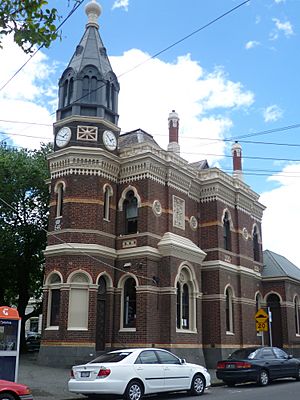Flemington Post Office facts for kids
Quick facts for kids Flemington Post Office |
|
|---|---|
 |
|
| Location | 2A Wellington Street, Flemington, Victoria, Australia |
| Official name: Flemington Post Office | |
| Type | Listed place (Historic) |
| Designated | 8 November 2011 |
| Reference no. | 105517 |
| Lua error in Module:Location_map at line 420: attempt to index field 'wikibase' (a nil value). | |
The Flemington Post Office is a special building in Flemington, Victoria, Australia. It is located at 2A Wellington Street. This historic post office is very important. It was added to the Commonwealth Heritage List on 8 November 2011. This means it is protected because of its history and unique design.
Contents
History of the Flemington Post Office
The first official post office in Flemington opened in the 1880s. Before that, smaller, unofficial post offices had been around since the 1850s. Architect J. R. Brown designed the new building in 1888. He worked for the Department of Public Works. Another architect, Alexander James Macdonald, designed the tower. The building was finished in 1889.
The post office was moved to Wellington Street in 1890. This was done to be closer to the growing shopping area. Around the 1920s, public telephone booths were added outside. A special cast iron pillar box for mail was also put on the footpath.
Over the years, some parts of the building changed. For example, the roof of a side porch was replaced. The original clock faces on the tower were also changed. By 1963, the outside of the building was painted white. Signs were added to the main tower.
Inside, changes were made to make the post office more modern. Old wooden parts were painted over. New flooring was put in. The back of the main counter was updated for new equipment. In 1989-90, large additions were built at the back. These included a mail room and a place for post office boxes. This made the building bigger and more useful.
What the Flemington Post Office Looks Like
The Flemington Post Office is located at 2A Wellington Street, on the corner of Shields Street. It was built between 1888 and 1889. The building has two stories and is made of brick. It has special stucco decorations.
The most noticeable part of the building is its tall, eight-sided tower. This tower has a unique conical roof. It also has an onion dome and a crescent moon decoration at the very top. These features remind people of Moorish architecture, which is a style from North Africa and Spain.
The building is on a triangular piece of land. It is only about 50 metres from the main shopping area. Its design works well with other nearby historic buildings. These include the Kennedy Terrace and the Court House and Police Station.
The back of the building has a service yard. It has a covered area for loading mail. The front of the building along Wellington Street has an original cast iron fence. This fence is set on a bluestone base.
The building uses different coloured bricks. It has brown bricks for the main walls. Red, white, and black lines of bricks add to its look. The windows and other parts are decorated with detailed stucco work. The roof has different shapes and is covered with slate tiles.
The windows are arranged neatly. They have different arch shapes and designs. The main entrances have wooden doors. The former private entrance has special etched ruby glass.
Condition of the Building
The Flemington Post Office is generally in very good condition. The outside of the building still shows its original design. Even with the additions built in 1989, it looks much like it did when it was first built. The outside is well-maintained.
Inside, some changes were made in 1989. However, many original features are still there. For example, the original curved counter and arched screen in the public area are still intact. The building is well looked after.
Why the Flemington Post Office is Important
The Flemington Post Office is important for many reasons. It was one of the first major public buildings in Flemington. It was built after the gold rush period. It replaced an older post office that had been there since at least 1869. The post office was even featured on a national postage stamp series. This shows how important it is to Australia.
The building is a great example of a large suburban post office with living quarters. Its design is very clever, especially because it was built on an unusual triangular piece of land. Its style mixes different architectural ideas from the Victorian and Federation periods. The unexpected Moorish decorations make it truly unique. Experts believe it is one of the most skillful designs by the Public Works Department architects of that time.
The Flemington Post Office also stands out because of its tall tower and prominent location. It can be seen from many directions. This makes it a landmark in the area. It is a distinguished part of the Flemington Hill Conservation Area. This area is known for its well-preserved Victorian buildings.
The building also has social importance for the people of Melbourne. It has provided postal services for almost 120 years. People value its unique look and design. It is also linked to three talented architects: JT Kelleher, AJ McDonald, and JR Brown. They worked for the Public Works Department in the late 1800s. Their work produced many notable buildings, and Flemington Post Office is one of the most distinguished.
The important parts of the Flemington Post Office include the main building and its corner tower, built in 1889-90.

